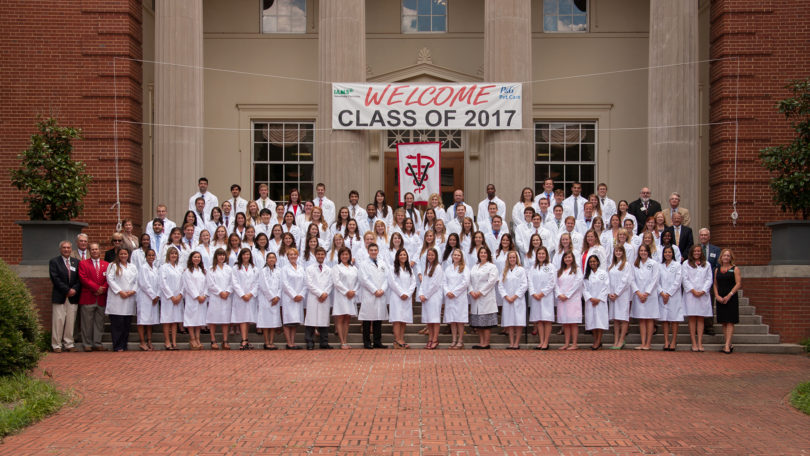Athens, Ga. – The University of Georgia College of Veterinary Medicine welcomed the class of 2017 during its annual White Coat Ceremony Aug. 11. Sponsored by the Georgia Veterinary Medical Association, the event officially recognized 102 members of the incoming class by donning them in lab coats to be worn during their veterinary education.
The hour-long ceremony was held in Mahler Auditorium at the UGA Hotel and Conference Center. After the ceremony, Dr. Denise Funk, president of the Georgia Veterinary Medical Association and class of 1992, led the two-block recessional of coated students to the College of Veterinary Medicine for a class photo, followed by a reception with the students’ families and members of the college’s faculty and staff.
The incoming class is made up of 72 women and 30 men. The students have a wide variety of veterinary medicine interests: 25 percent are interested in companion animal medicine, 25 percent in mixed-animal medicine, 10 percent in zoo animal and wildlife medicine, 8 percent in food animal medicine, 2 percent in public health, 3 percent in equine medicine, 23 percent in pursuing a post-doctoral internship/residency and 4 percent in research.
“The white coat is the symbol of medical professionalism. This ceremony, where our first-year students are coated and hear the Veterinarian’s Oath for the first time, reminds them that they are beginning their education in one of the most respected medical professions,” said Dr. K. Paige Carmichael, the college’s associate dean for academic affairs.
UGA College of Veterinary Medicine
The College of Veterinary Medicine, founded in 1946 at UGA, is dedicated to training future veterinarians, conducting research related to animal and human diseases and providing veterinary services for animals and their owners. Research efforts are aimed at enhancing the quality of life for animals and people, improving the productivity of poultry and livestock and preserving a healthy interface between wildlife and people in the environment they share. The college enrolls 102 students each fall out of more than 800 who apply. For more information, see www.vet.uga.edu.
The current College of Veterinary Medicine Teaching Hospital, built in 1979, serves more than 20,000 patients a year in one of the smallest teaching hospitals in the U.S. The college is currently building a new veterinary medical learning center, which will include a new teaching hospital as well as classrooms and laboratories that will allow for the education of more veterinarians.







